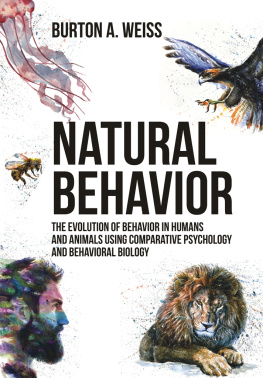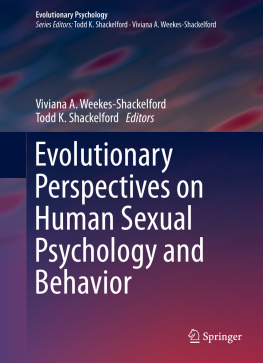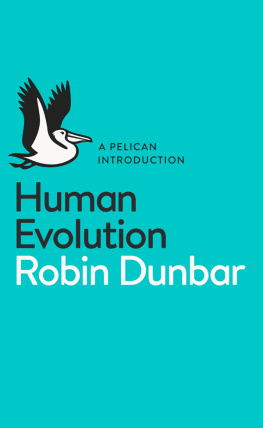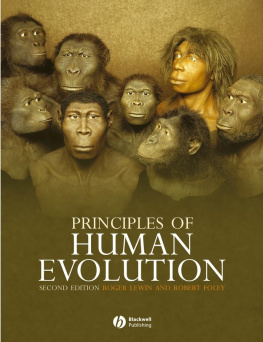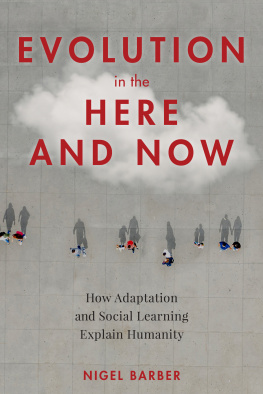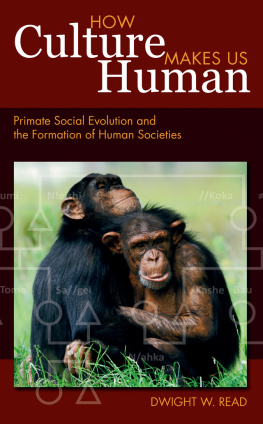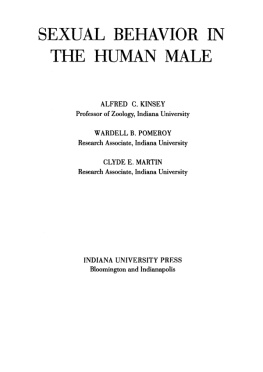Peter B. Gray - Evolution and Human Sexual Behavior
Here you can read online Peter B. Gray - Evolution and Human Sexual Behavior full text of the book (entire story) in english for free. Download pdf and epub, get meaning, cover and reviews about this ebook. year: 2013, publisher: Harvard University Press, genre: Romance novel. Description of the work, (preface) as well as reviews are available. Best literature library LitArk.com created for fans of good reading and offers a wide selection of genres:
Romance novel
Science fiction
Adventure
Detective
Science
History
Home and family
Prose
Art
Politics
Computer
Non-fiction
Religion
Business
Children
Humor
Choose a favorite category and find really read worthwhile books. Enjoy immersion in the world of imagination, feel the emotions of the characters or learn something new for yourself, make an fascinating discovery.

- Book:Evolution and Human Sexual Behavior
- Author:
- Publisher:Harvard University Press
- Genre:
- Year:2013
- Rating:5 / 5
- Favourites:Add to favourites
- Your mark:
- 100
- 1
- 2
- 3
- 4
- 5
Evolution and Human Sexual Behavior: summary, description and annotation
We offer to read an annotation, description, summary or preface (depends on what the author of the book "Evolution and Human Sexual Behavior" wrote himself). If you haven't found the necessary information about the book — write in the comments, we will try to find it.
Evolution and Human Sexual Behavior — read online for free the complete book (whole text) full work
Below is the text of the book, divided by pages. System saving the place of the last page read, allows you to conveniently read the book "Evolution and Human Sexual Behavior" online for free, without having to search again every time where you left off. Put a bookmark, and you can go to the page where you finished reading at any time.
Font size:
Interval:
Bookmark:
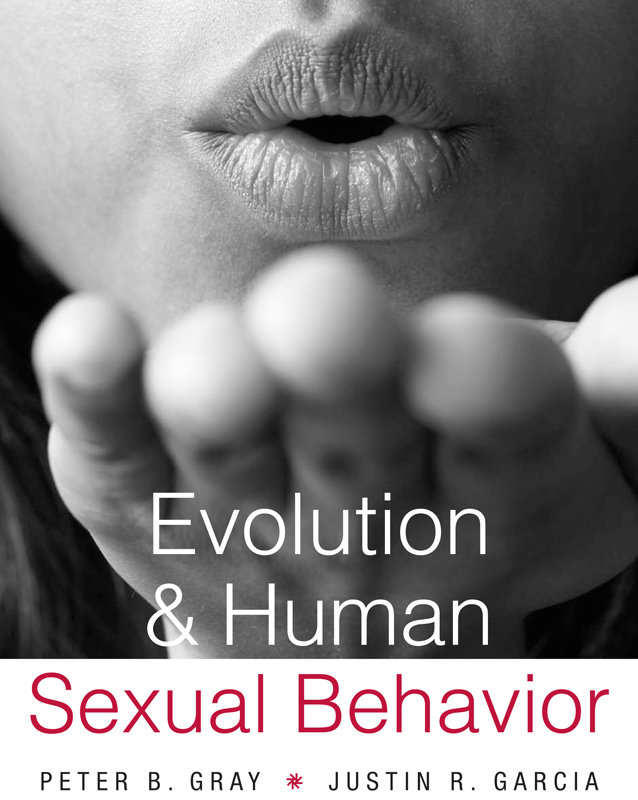
Evolution and Human Sexual Behavior
Evolution AND
Human Sexual Behavior
PETER B. GRAY
JUSTIN R. GARCIA
HARVARD UNIVERSITY PRESS
Cambridge, Massachusetts, and London, England | 2013
Copyright 2013 by the President and Fellows of Harvard College
All rights reserved
Photo: Thinkstock/Getty Images
Design: Jill Breitbarth
The Library of Congress has cataloged the printed edition as follows:
Gray, Peter B., 1972
Evolution and human sexual behavior / Peter B. Gray and Justin R. Garcia.
p. cm.
Includes bibliographical references and index.
ISBN 978-0-674-07273-2 (hbk. : alk. paper)
1. Sex (Psychology) 2. Sex (Biology) 3. Sex. 4. Human evolution. I. Garcia, Justin R., 1985 II. Title
BF692.G687 2013
306.7dc23 2012037630
PBG:
For Megan
JRG:
For Helen
Contents
For may we not infer as probably that marriage between near relations is likewise in some way injurious,that some unknown great good is derived from-the union of individuals which have been kept distinct for many generations?
Charles Darwin, On the Various Contrivances by Which British and Foreign Orchids are Fertilized by Insects, and on the Good Effects of Intercrossing
While Darwins journals and books inform us of his ideas, his experiments, and his theories, they are largely silent on the most intimate of details. We do know that he was concerned over potentially negative effects of fathering children with his wife and cousin, Emma; the epigraph above reflects this concern, though Darwins worries were later assuaged through research conducted by his son George. We do know that his marriage was a fruitful union, for he and Emma had ten children. We also know that, despite any fears of inbreeding, he felt a deep love for his wife and enjoyed a long, committed, marriage to her.
We can make some level-headed guesses about the sexual world Darwin inhabited based on the time and place in which he lived. Rather than attempt to personalize, in a sordid and uneasy way, what actually happened in Charles and Emma Darwins bedroom, let us instead imagine a typical couple of the late nineteenth-century English gentry. Doing so will help illustrate how any given individuals sexual behavior bears the sexual marks of his or her evolutionary ancestors in addition to the cultural environment in which he or she was raised.
Such a generalized person probably had wondered about sex during his or her upbringing, engaged in curious sex play with childhood acquaintances, masturbated during pubertal years, and likely married a long-term partner. Such a person probably had intercourse on a bed, engaged in sex during night hours, presumably in the most typical of sexual positions (the missionary position), and at some point produced offspring. This person likely attempted to shield the children from direct view (and earshot) of parental sex; engaged in less sex during times in which a woman was on her period or late in pregnancy, or in the spell after having given birth to one of her offspring; and this person probably experienced a decline in intercourse frequency with advancing age. These are characteristics of behavior that applied to men and women of the time; with the exception of having sex on a bed, these are also, as we will see, quite typical patterns among people the world over. Yet we will also see variation on these themes (for example, variable liberty granted for masturbation, and variation in potential marital partners).
None of this sexual patterning may strike you as unusual. Now step out of your bipedal shoes and suppose you were a chimpanzee in an African rainforest. From a chimpanzees-eye view, what would you think of these kinds of human sexual practices? You might have a host of questions. Why have clothes that require removal? Why have sex on a bed? Why have sex away from ones offspring and other adults? As a chimpanzee, you know that sex is easier without clothing that interferes with the act; clothing also impinges on ones ability to readily view the signals that facilitate a sexual encounter, such as a females sexual swelling or a males erect penis. Sex also works just fine without any special linen surfaces or candlelightreally, any spot will do. There is nothing wrong with sex outdoors, on the ground, and under sunlight. You would also know that sometimes it is preferable to sequester yourself and a partner during sex (away from a dominant male, perhaps, who might be irked if he caught the two of you), but that most times sex in view of fellow chimpanzees is fine. Well, maybe not if you are a mother whose nearby offspring resent your displaced passions and attempt to separate you from your mate (now that is parent-offspring conflict!). You would also puzzle over the missionary position. As a chimpanzee, most of your sexual behavior entails males mating with females from behind. Yet those strange humans rarely resort to that position.
Our imaginary-chimpanzee thought experiment reminds us that we take many details of human sexual behavior for granted. We may not realize that some of these features of our sexuality beg for explanation. We also may not realize how an evolutionary perspective can help contextualize and explain the specifics of our sexual lives. Our aim in this book is to present a concise, accessible, current, and integrative account of human sexual behavior. We seek to cover a wide human sexual terrain, synthesized within an overarching evolutionary perspective. We seek to combine substance with an enjoyable narrative. We hope the readers who come along on our tour will include academics, students, and the curious coffee-shop customer (several sat near Peter in a Las Vegas Starbucks as he wrote many of the words in this book; we wonder how many may have speculated on what he was actually writing about). And we hope that Darwin himself would have enjoyed this evolutionary perspective on human sexual behavior if he were alive today.
We also recognize our own biases in this explorationhow our own worldviews, family life, and personal and professional experiences shape our views of human sexuality. Peter, the lead contributor to this work, is a biological anthropologist at the University of Nevada, Las Vegas. Justin is an evolutionary biologist at The Kinsey Institute for Research in Sex, Gender, and Reproduction, at Indiana University, Bloomington. This project is our honest attempt to synthesize a large body of divergent literature in an accessible, integrative, and scholarly way. We are both active researchers, with diverse experiences, and genuinely intrigued by studies of human nature. We asked ourselves how our own views might color our interpretations, not to mention how this book may shade others views of us. With this in mind, we have tried to make the book evenhandedto avoid advocating any particular cause. Popular science writer Mary Roach put it best in Foreplay at the beginning of her book Bonk: The Curious Coupling of Science and Sex: This book is a tribute to the men and women who dared. Who, to this day, endure ignorance, closed minds, righteousness, and prudery. Their lives are not easy. But their cocktail parties are the best.
Good science begins with a question. A compelling book should too. We have already raised some questions concerning human sexual behavior, examples of questions that we will address throughout the book. There are many more good questions that readers might ask. Why do sex differences in behavior exist? How do patterns of human same-sex sexuality compare with those of other animals? How does an evolutionary perspective make sense of a world of Internet pornography, breast enhancement, and sex tourism? We could keep going, but these examples reveal the flavor of the kinds of questions we hope to address in the course of this book.
Font size:
Interval:
Bookmark:
Similar books «Evolution and Human Sexual Behavior»
Look at similar books to Evolution and Human Sexual Behavior. We have selected literature similar in name and meaning in the hope of providing readers with more options to find new, interesting, not yet read works.
Discussion, reviews of the book Evolution and Human Sexual Behavior and just readers' own opinions. Leave your comments, write what you think about the work, its meaning or the main characters. Specify what exactly you liked and what you didn't like, and why you think so.

